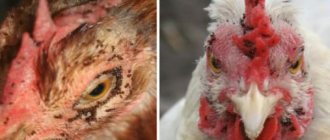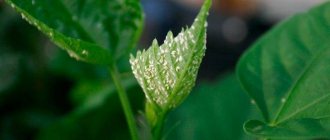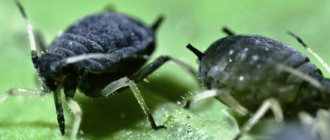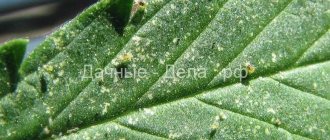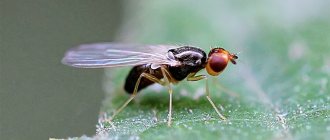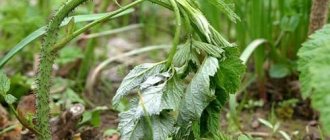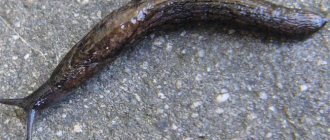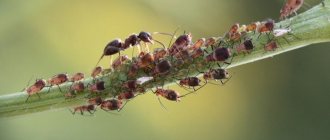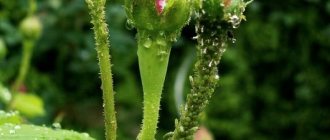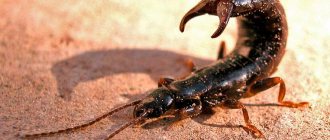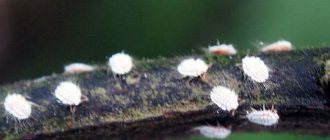Among the early berries that many people enjoy, cherries occupy a special place. Already in June, cherry trees look bright and elegant, thanks to the juicy dark red berries. Harvesting does not always go well if aphids appear on cherry leaves.
It is difficult to believe that insects from the group of Homoptera proboscis feeding on plant sap can settle on dense leaf plates. The small insect multiplies quickly and forms a real colony. Experts recommend how to get rid of aphids on cherries so that the berries are not damaged and the tree retains its strength for the next season.
How to get rid
During the season, aphids produce 14 generations, and if measures are not taken in time, they will infect and destroy the entire garden. Let's find out how to fight aphids on cherries.
Folk remedies
Folk remedies are used for prevention, at the very beginning of infection and in cases when harvest time is approaching, which means that the use of industrial poisons will be dangerous to human health.
Treating trees with soapy water has worked well. Half a bar of laundry soap should be grated and dissolved in 10 liters of liquid. By the way, soap can be added to other products: it improves the adhesion of active particles to the sheet.
You can get rid of parasites using wood ash: 500 g are poured into 5 liters of water and left for 3 days. You can speed up the process by adding 300 g of ash to water and boiling it for half an hour. The resulting concentrate is diluted with water to 10 liters. Spraying should be carried out at least 3 times with an interval of 10 days.
A garlic solution is effective against aphids: chop 200 g of cloves and add 1 liter of water, then leave for 5 days in a dark place. Before spraying, the concentrate is diluted in a proportion of 100 ml of infusion per 5 liters of water. The remainder of the product can be stored in a dark bottle. The tree is sprayed with this infusion for 2-3 days in a row, then take a break for a week and repeat the cycle again.
By the way, when you break off the arrows of garlic, use them to rub the trunk of cherry trees and other trees vulnerable to aphids: this smell repels ants.
You can treat cherries with a solution of dry mustard: pour 100 g of powder into 10 liters of water and add a little liquid soap.
Another environmentally friendly method of control: using natural predators against aphids, that is, ladybugs and lacewings. Lots of their larvae are sold in large garden centers. You can also attract ladybugs by planting herbs or calendula next to the cherry tree.
Chemical
Now we’ll find out how to treat a heavily infected tree.
Chemicals help quickly and effectively fight parasites, but it is better to use them in the spring, when there is still a lot of time left before harvesting.
Many gardeners recommend Fitoverm - this biological preparation is relatively safe for the environment. Spraying is carried out twice, before and after flowering, but not during it. The optimal break between spraying is 20 days.
"Confidor" kills pests and at the same time has a beneficial effect on leaf growth. Just one treatment per season is enough. For small numbers of aphids, a proportion of 2 g of the drug per 10 liters of water is recommended. If the infestation is severe, the concentration should be twice as high. This product is well suited for southern regions, because even in the heat it does not lose its effectiveness.
If the aphids on the cherry have multiplied greatly and managed to noticeably damage the leaves, the drug “Spark Double Effect” is recommended. It not only quickly destroys parasites, but also helps the tree recover faster due to the potassium it contains.
Herbal infusions and decoctions
There must be a “garden pharmacy” on every site or beyond. These are plants that repel aphids and other pests. Gardeners have long known recipes for infusions and decoctions from available wild and garden crops.
Here is a small list of plants and recipes for preparing protective equipment from them:
Tobacco
The infusion is prepared in this ratio
40 g of crushed fresh leaves for every liter of water.
Pour water over the tobacco and leave for two days. Before use, strain the infusion and add water 1:2.
According to another recipe, an infusion can be prepared from dry tobacco dust. You will need half a glass. The powder is poured into a liter of water and boiled for 0.5 hours. The broth is infused for two days in a dark place. After 2 days, you can filter it and add 2 liters of water. At this concentration it is ready for use.
Photo 4. Tobacco dust is a well-known insecticidal agent against aphids and other pests.
Elderberry
Our ancestors planted bushes near the house to repel annoying insects. Modern experts call this plant a natural insecticide. The specific smell of elderberry is not to the liking of ants and aphids. Even if it is not in your garden, you can find it in a forest or park and make an infusion from it:
Pour 1 kg of young leaves (crushed) into 10 liters of water and leave for 12 hours. To process cherries, the infusion must be strained.
Pyrethrum or Dalmatian chamomile
For infusion, you can use dry raw materials. It is prepared from inflorescences and dried in the shade.
To prepare the insecticide, you need 200 g of chamomile per 10 liters of water, leave for 12 hours.
The filtered cake can be filled again, but with a smaller volume of water - 5 liters.
Photo 5. Pyrethrum is sold in garden stores. It is produced in the form of a dry powder.
Insects and plants in the fight against aphids
Biological methods of control are considered one of the most effective. Once you place a ladybug on your property, it will immediately begin to absorb harmful guests. In just one day, one assistant will eat two hundred parasites.
Nurse insects that will help rid the area of an aphid colony:
- lacewings;
- flower flies;
- Red ants do not feed on aphids, but are enemies of black ants. This species is considered an ally of aphids; such insects are not afraid of fire, as they hide deep in the soil. Red ants will help destroy black ants.
Sparrows, tits, linnets are biological weapons against pests
It is important to attract all these creatures to the site and not create situations that are dangerous for their existence. For example, many beneficial insects overwinter in fallen leaves and dry grass
Ladybugs will love corn tops. To burn it all means to deprive of helpers, to provide aphids with a poorly protected garden.
Video about the use of ammonia and laundry soap.
A powerful remedy against aphids is plants. It is worth planting henbane, tobacco, dandelion, basil, wormwood, garlic, onions, horseradish, cornflower, and shepherd's purse on the site. Petunia, begonia, nasturtium, the beloved mallow, bird cherry, and viburnum, on the contrary, attract aphids, so they should be planted as far as possible from fruit crops.
conclusions
Different varieties of cherries, such as Miracle, Shubinka, are attacked by many different pests. One of the insects that harm cherry trees is aphids. The most effective methods of combating it are chemical agents:
- Carbolinium solution.
- DNOC.
- Metaphos.
- Karbofos.
- Anabasine sulfate, nicotine sulfate and others.
Biological methods of controlling aphids are also often used. Beneficial insects that eat harmful ones help with this:
- Sunny (five-spotted ladybug).
- Lacewing.
- Trichogramma.
To ensure that the products in the garden are environmentally friendly, gardeners often use various folk remedies to destroy and prevent the appearance of aphids on cherry trees.
Sources
- https://DachaMechty.ru/vishnya/14-tlya-kak-izbavitsya.html
- https://tlia.ru/kak-borotsya-s-tlyoj-na-vishne/
- https://babushkinadacha.ru/bolezni-i-vrediteli/vrediteli-chereshni-i-vishni-mery-borby-s-nimi.html
- https://KomnatnieCveti.ru/yagody/vishnevaya-tlya-2.html
- https://glav-dacha.ru/kak-izbavitsya-ot-tli-na-vishne/
- https://KinzaRostov.ru/yagody/vishnevaya-tlya-2.html
- https://fermilon.ru/sad-i-ogorod/vrediteli/tlya-na-vishne-narodnye-sredstva-i-preparaty-dlya-borby-s-vreditelem.html
- https://PchelkinaStrana.ru/sad/chernaya-tlya-na-vishne.html
- https://PoFerme.com/sad/derevya/vishni/bol-vish/sposoby-borby-s-tlej.html
[collapse]
Methods for controlling aphids
There are several basic methods that can be used to control aphids with varying effectiveness:
- Chemical compositions. Chemicals show the greatest effectiveness, but insecticides can then get into food and cause damage, not to the aphids, but to the body.
- Physical methods. Collecting and cleaning aphids manually is the cheapest and easiest way, but the effectiveness of this method is very questionable and requires a lot of time.
- Biological methods. Using birds and insects that feed on aphids is considered the safest method from an environmental point of view. The effectiveness of this method is extremely low and does not bring the desired result.
- Traditional methods. The use of natural substances that repel or kill insects gives results only slightly worse than chemical substances. However, they are harmless to plants and further consumption of processed cherries.
Thus, treatment of plants with chemical and natural substances shows sufficient effectiveness.
Folk remedies
- Garlic infusion. This solution is prepared in a concentration of 100 g. garlic per 10 liters of water. It should be infused for 2 days, after which it will be ready for use.
- Infusion of tobacco. Preparation of the solution is as simple as possible. The tobacco is filled with water, after which it is infused for a day. This infusion is used in a concentration of 1:3.
- Infusion of celandine. Celandine is mixed with potato or tomato tops and filled with water. After 3 days of infusion, the solution is ready for treating trees.
- Infusion of onion peel. The most common infusion due to its availability, since almost every gardener grows onions on his plot.
- Nettle infusion. For 10 liters of water, take 1 kg of nettle leaves. This solution should be infused for several days.
- An infusion based on a mixture of ash and laundry soap.
Treating cherries and cherries with such means makes their leaves completely unsuitable for aphids, but this does not cause any harm to the trees themselves. The use of such solutions should be carried out once a week, starting from the moment the buds open. Timely start of tree treatment helps to solve the problem of how to get rid of aphids on cherries in the spring.
Treatment of trees during flowering should be limited so as not to frighten off pollinating insects. This is especially true for treatment with chemicals.
Chemicals
The use of chemicals should be carried out in cases where traditional methods have not given the desired result.
- Drug Iskra. This insecticide makes it possible to destroy not only the aphid population, but also caterpillars that feed on the leaves of cherries and other fruit trees. Minerals, which are included in the composition as an additional component, allow the leaves to quickly regenerate and recover from damage by insects.
- The drug Commander. A very powerful drug that can protect tree leaves from insects for a long time. Helps cope with even severe aphid infestations. One treatment with this preparation is enough to protect trees for the entire season. This drug will be a good solution if you don’t know how to get rid of aphids on cherries in the summer.
- The drug Fitoverm. Using the right combination of chemical and natural components of the drug makes it minimally harmful to humans. The only drug that can be used even a week before harvest.
The modern chemical industry provides gardeners with a huge number of products for treating plants against insects. Read the instructions carefully before using the medications and follow them exactly. This will help avoid unpleasant situations.
Plum tree disease red spot
The description of this disease of plums is similar to the description of red spot in all other stone fruit trees. The main signs of this plum leaf disease are yellowish or light red spots on both sides of the leaf. As the disease progresses, the spots thicken and become bright red and shiny. The spots on fallen leaves darken.
Trees affected by this disease weaken and their winter hardiness decreases. Flowers and ovaries often fall off.
Below are photos of this plum disease and methods of combating the disease:
To combat red spot, trees and soil are recommended to be generously sprayed with a solution of copper sulfate. This procedure should be carried out before the buds open.
Immediately after plum blossoms, you can spray the trees with a 1% solution of Bordeaux mixture (100 g per 10 liters of water). If the disease spreads strongly, the procedure should be repeated 2-3 weeks after flowering.
It is necessary to promptly remove all fallen leaves under garden trees and dig up the soil in the tree trunk circle, since this is where fungal spores overwinter.
It is recommended to choose plum and cherry plum varieties that are resistant to this disease.
Prevention
To prevent aphids from attacking the cherry, preventive measures are carried out. Trees protect against ants, which spread pests to fruit crops. To do this, in early June, a sticky belt or a foil skirt is put on the trunk.
We must not forget about the following preventive measures:
- The plant should be provided with good watering and fertilizing.
- Near the trunk it is worth removing all the weeds and sowing marigolds and tansy.
- It is necessary to remove nests of garden ants from the area.
- Trees should be constantly inspected.
- Mulching must be used. Celandine, mint, and wormwood are suitable for this purpose.
It is not only the green crowns that need to be monitored. Small aphids move to cherries from any other crop. In early spring and autumn, it is necessary to remove old bark and whiten tree trunks. This will protect them from insects and rodents.
Dealing with aphids on cherries is easy, but you need to choose the right remedy. Chemicals can quickly kill aphids, but they should not be used on cherries during the flowering period. In this case, folk recipes will help out. Control measures include prevention.
Preventive action
In order not to look for methods on how to deal with aphids on cherries, you should take preventive measures.
The simplest methods are described below. Some of them are based on long-term observations of wildlife, others are specific methods of caring for plants.
- Every year, in late autumn and early spring, cherry tree trunks should be bleached with lime. This action will repel insects and help prevent the appearance of clutches of their eggs. Before applying whitewash, dry and damaged bark should be removed from the tree trunk.
- Throughout the summer, weeds growing close to the tree trunk should be controlled. Aphids settle on herbaceous plants, and then they move to cherries. If the weeds are not destroyed, the pest will eventually colonize not only fruit trees, but also vegetable crops.
- Avoid the proximity of cherry trees to viburnum, linden and hawthorn, because these trees attract aphids with their aroma.
- Mulch the soil under the trees and regularly apply mineral fertilizers. Such measures will help strengthen plant resistance to diseases and pests.
- You should get rid of ants using boiling water or any other means.
Following these simple recommendations will reduce the risk of aphids on cherries, plums and currants to a minimum.
To combat cherry pests in your area, attract insects to the garden for which aphids are food - ladybugs. To do this, plant herbaceous plants with a strong smell nearby:
- marigold;
- cilantro;
- dill;
- fennel;
- lovage;
- parsley.
Parsley planted near a cherry tree will help get rid of aphids
How dangerous are garden aphids?
Unfortunately, it is extremely difficult to notice a pest invasion quickly. By the time the gardener discovers the insects, they will have time to cause serious damage to the fruit tree. To maintain normal life, aphids need a lot of moisture.
Aphid invasion
Using the proboscis, the insect pierces the soft tissue of a leaf blade or bud. In affected plants, the metabolic process is disrupted, amino acid access to the damaged areas is terminated, and the following are observed:
- curling of leaf plates and their early falling off;
- deformation of shoot tips;
- formation of growths on the stem part;
- cultural oppression;
- falling of ovaries and buds;
- spread of fungal infections;
- death of the tree.
Important! The yield of insect-infested trees is reduced. The growth rate of the crop slows down
If you do not help the plant in a timely manner and do not treat the leaf blades, then the fruit crop will not survive severe frosts.
Below you can find out how to treat trees against aphids to save your garden. By keeping the trees in your own garden healthy, you can reduce the risk of aphids starting to appear on your plants.
Note! The first sign of infection of a fruit tree by aphids is the appearance of small black dots on the inside of the leaf blades.
Spraying with soap solution
Methods for controlling aphids on indoor flowers
If you find aphids on plants in a room, you should immediately begin to fight them. For this purpose, there are various methods of control - chemical, biological, environmental and folk. Each method is selected depending on the degree of damage to indoor plants.
Chemicals
This is an effective and therefore often used method of combating parasites, and aphids are no exception. The essence of the method is that the affected areas are sprayed with a special chemical. These drugs are guaranteed to kill aphids without causing significant harm to the environment. Modern chemical preparations include essential oils and fatty acids.
If parasites are detected at the initial stage, when they have not yet completely taken over the flower, then the affected parts can be removed mechanically. This will not harm the flower, but will protect it from further spread of parasites. The remaining parts can be treated with soapy water.
In case of mass infection of a flower, the following chemicals are used:
- Actorin.
- Aktara.
- Fitoverm.
- Kinmiks.
The use of the above listed means requires certain rules, which helps prevent the reappearance of pests. For example:
- If you treat, then treat all plants, regardless of their condition, since parasites can easily move to other plants. Therefore, such an approach will allow you to get rid of such troubles.
- Aphids quickly adapt to existing drugs, so it is not recommended to treat the plant twice with the same composition.
Biological method
The biological control method involves populating the garden with natural enemies of aphids, such as wasps, ladybugs and lacewings. In your home garden, you should plant flowers that attract natural enemies of aphids. This approach will minimize the appearance and also reduce the rate of reproduction of aphids.
Aphid. Home remedy.
Watch this video on YouTube
Folk remedies for aphids
Folk methods of struggle are distinguished by their harmlessness, both for humans and domestic animals. At the same time, they are considered quite effective in pest control. The main thing is to prepare the product correctly and use it for its intended purpose.
Proven means:
- Hogweed leaves help effectively fight against both aphids and spider mites. To prepare the active composition, you need to take 100 grams of hogweed leaves and infuse them in 1 liter of water for several days. This infusion should be sprayed on all house plants.
- In the same way, an infusion of marigolds is prepared. It is better to use fresh shoots for the solution.
- Mustard has an equally effective protective effect. 10 grams of concentrated mustard is dissolved in 1 liter of water. All affected plants are sprayed with this solution.
- The use of Datura also helps in the fight against aphids. To do this, you need to grind the leaves of this plant, pour soapy water, after which the affected flowers are sprayed with this composition.
- The same effect can be expected if tobacco leaves are used in this way.
- If you chop 30 grams of garlic and pour water over them, then using this mixture you should wipe the leaves of the plant on which the aphids have settled.
- A decoction of yarrow will also help get rid of this parasite. To do this, you need to take 80 grams of the original product and boil it in 500 ml of water. All parts of the plant are wiped with this solution.
- Celandine also has the same properties. After the decoction is ready, it needs to be infused for about two weeks. The decoction contains toxic substances that destroy such pests.
- Using the same principle, it is possible to prepare an infusion of dandelions. Dandelion infusion can be stored for a long time. Therefore, having prepared the solution once, it is used from time to time to treat house plants.
AMONGIA IS A SUPER RESIDENT FOR APHIES!!!
Watch this video on YouTube
Ecological control methods
These are the methods that are considered the safest. These include:
- Removing affected parts of the plant. It is used when the lesions are still very minor.
- Wiping parts of indoor plants with soapy water.
- Treatment with oil solutions, which are safe for both flowers and buds, but it is still not recommended to treat the buds, as they may wither.
Effective preparations for aphids on fruit trees
Buying chemicals does not guarantee a successful solution to the problem if you use them thoughtlessly. Each of the four groups has its own terms and recommendations for use.
- Systemic preparations against aphids on trees have the ability to penetrate plant tissue. Then the juice becomes poison for aphids; it persists for a long time and is not washed off by any rain. After treatment, the insects die, and it is possible to get rid of them within two weeks.
- Contact preparations fall on insects and kill them. For these chemicals, treatment at the site of injury is important.
- Intestinal preparations work within a few hours after entering the insect’s body.
- Biological drugs are considered a modern, safe solution to problems. But their storage directly affects work efficiency.
"Aktara" for aphids on trees
This drug is called a broad-spectrum insecticide. Within an hour after the first treatment of the tree, the aphids will lose interest in eating young leaves. An interval of one week is maintained between two treatments. The third class of hazard of the substance should be taken into account; be sure to warn beekeepers in the area before use. "Aktara" works against aphids by penetrating into the wood tissue. This ability helps to get rid of insects that live hidden in the bark or other parts of the tree.
"Karbofos" against aphids on fruit trees
The recognizable sharp smell of the substance and the quick result are the calling card of the chemical. Its main advantage over other insecticides is its effect time of only one to two weeks. Then complete destruction occurs without harm to human health. The specific pungent odor will disappear after some time, but the protection will remain. "Karbofos" against aphids is effective only for adult individuals, because it acts through the intestines.
It should be sprayed immediately after the pests emerge; the pupae and oviposition will remain undamaged. It is necessary to accurately calculate the processing time so as not to cause damage to beneficial insects. They will begin their years almost immediately after the emergence of adult aphids. This is the period immediately before the buds open. You can re-treat the plants at the moment the buds turn pink.
"Commander" for aphids on trees
This is a representative of systemic chemicals, produced in the form of ampoules with a concentrated substance. The product helps get rid of larvae and adults. The advantage is the sticking effect; “Commander” against aphids remains effective even during extreme heat or rain. Economical consumption and affordable price are the main reasons for gardeners choosing this drug.
Biological products against aphids on fruit trees
"Fitoverm" is available in ampoules, which should be diluted in water. The advantage of the biological product is its effectiveness and safety even at the fruiting stage. By treating the tree a week before harvest, you can preserve the fruits and not cause harm to your health. When choosing biological products against aphids, you should carefully read the storage conditions and instructions for use, because the result directly depends on this.
The systemic biological drug "Actofit" is sprayed twice. From an 8 ml ampoule, a solution is prepared in a liter of water and the tree is treated at intervals of two weeks. "Strela" is available in powder form. After treatment, the solution is quickly absorbed by the leaves, and the product penetrates into other parts of the plant. Apply after the first signs of insects. It retains its effectiveness for three weeks and works within two weeks after spraying.
Harmless insect repellents
If aphids appear on a cherry, you can always resort to special means. They will quickly deal with insects, but particles of poison can get into any part of the plant, and fruits are no exception.
There are such drugs on sale. But it is recommended to use them only as a last resort, when the garden is heavily attacked by aphids. Insecticides are also known to be dangerous to bees.
The wood is treated at intervals of 10 days; it is important to follow the instructions for the product and not store the prepared composition.
"Fitoverm"
You can also destroy aphids with the biological agent “Fitoverm”, which is saturated with toxic substances of natural origin.
Not all gardeners have the opportunity to collect plant materials and prepare decoctions and infusions. In this case, biological means of protection will help out. They do not harm plants and do not accumulate in fruits. Therefore, they can be used even when ripening cherries. The waiting period for such insecticides is only three days.
The following drugs are widely popular:
- Aktofit,
- Actarophyte,
- Aktoverm,
- Fitoverm,
- Verticillin - M,
- Bitoxibacillin – BTU – M,
- Gaupsin.
Chemicals
Chemicals for controlling aphids
Cherry aphids will disappear if you treat the plant with store-bought products. These drugs cannot be used while the tree is flowering because they harm bees and poison future fruits.
All chemistry is divided into three groups:
- intestinal preparations;
- contact;
- systemic.
Intestinal remedies are the most effective. They are used when many insects are found on the leaves of cherries, cherries or plums. They enter the aphid's body during a meal and instantly poison it. You can spray cherries with the following preparations:
- BI-58 New;
- Confidor.
Contact agents penetrate the body through the chitinous membrane of the insect and can remove aphids in a few days. There is a risk that after treatment, aphids on cherries will survive and begin to reproduce again.
These chemicals include:
- Fufan;
- Arrivo;
- Karbafos.
Drugs from the last group are not washed off by precipitation, so they last a long time. They penetrate the plant sap and gradually poison the pest. The aphids disappear after two weeks. Systemic agents are the drug Aktara and Tanrek.
What kind of aphid is it and why is it dangerous?
Aphids are a frequent visitor to plots. This insect usually does not exceed 0.5 mm in length, which makes it difficult to detect early in the lesion. There are species reaching 7 mm. Gardeners notice aphids when their colonies become larger. First, a small black dot appears on the inside of the leaf. There the insect creates colonies.
Some species have wings to help them migrate. When treated with pesticides and other drugs, aphids fly from place to place in search of more suitable conditions. Wingless species also move around the site with the help of short legs, but within the nearest fruit crops.
The insect likes not only fruit trees and shrubs, but also vegetables, flowers, and ornamental plantings. For normal life, insects need moisture. With the help of a proboscis, aphids pierce the soft tissues of leaves and buds, thereby receiving nutrients. Due to the regular loss of amino acids, parts of the plant become depleted over time and stop developing.
Pest colonies on foliage
Signs of harmful activity of a pest colony:
- leaves fall prematurely;
- the edge of the leaf blade curls and darkens;
- plant shoots are deformed;
- growths appear on the trunk;
- the buds fall;
- the plant loses its ovaries;
- the overall growth of a tree or shrub slows down;
- the plant becomes so weak that it is no longer able to survive the winter cold.
Signs of pest damage
In addition to the deplorable condition of the leaves, there are several other consequences. Aphids on trees and other plants are visible to the naked eye. According to descriptions, the size of one individual does not exceed 8 mm in length. The aphid's body shape is oval. The color is almost always greenish, which is the best camouflage. Sometimes there are black, red or pink shades in color. A separate variety is the transparent aphid.
Why do aphids appear and how to prevent their invasion?
It often happens that cherries grow well for many years, without diseases or pests, but in some year aphids settle on them. And not only! Ants are actively scurrying around the tree with her. They are the ones who move the small pest to a new place. This symbiosis is explained by the ants' addiction to copper jelly, which is secreted by aphids. So they carry it all over the garden. In addition to ant transport, aphids can move independently when winged individuals appear during a certain breeding period. Unlike wingless offspring, they are excellent at moving over long distances, especially with the help of the wind.
Photo 1. Black or green aphids settle on the cherry. It is located on the back of the leaves.
Experienced gardeners rightly argue that it is better to prevent a problem than to hope that it will go away on its own. It is better to take care in advance to ensure that the pest does not settle in your garden. To do this, you need to take into account that for the full reproduction and spread of aphids, a certain set of weeds is necessary. For example, most of all she loves bedstraw. Its thickets are the most suitable environment for summer egg laying. The danger is that one viable female can produce three generations of aphids, with a total number of several hundred thousand winged and wingless individuals. By autumn, the pest lays eggs in the axils of the buds, the bends of the shoots, and in fallen leaves for the winter.
In the spring, when the leaves bloom on the cherry tree, at the same time the overwintered aphid eggs turn into larvae. Already at this stage of development, pests feed on fresh plant sap. To prevent their maturation and spread, it is necessary to carry out preventive spraying of trees in a timely manner. This must be done before flowering begins. It is better to use harmless products that will not interfere with budding and ovary formation. In the future, the quality and quantity of berries will depend on this.
To protect cherries from pests and at the same time get a good harvest, experienced gardeners have long used affordable, safe products that do not accumulate in the berries and do not cause harm to humans, animals and the environment. In addition, they are available and inexpensive. Let's tell you more about them.
Causes
Three main reasons for the spread:
- Affected trees have appeared in the neighboring garden, and since some species of aphids are winged, they can quickly move to neighboring trees.
- Black ants feed on the secretions of aphids and therefore can carry larvae while moving from one tree to another.
- Pests can produce up to 15 generations per season. They overwinter in the egg phase, from which larvae hatch in early spring and form numerous colonies. After 14 days, females emerge from the larvae, giving rise to a new generation.
Cherry aphids mainly inhabit the tops of young shoots. If the cherry is young, then by attacking the growth zones, aphids slowly kill the plant.
Why is it dangerous for trees?
This family of insects is quite a nasty pest. Settling on the underside of leaves, aphids suck juices from fresh green plants, destroying young shoots. At the same time, it secretes poison, which causes the leaves to curl, change shape and die, the shoots do not grow, and the tops become bent. Aphid waste - sweet secretions - contaminates the leaves, thereby disrupting the natural life of the plant. She also spreads viral infections through her saliva. Among fruit trees, the greatest damage occurs to young seedlings. Aphids are familiar small insects up to 7 mm. They have a special piercing-sucking proboscis, which they use to pierce the surface of leaves, buds or new shoots and suck out the juice. The plant is greatly weakened and becomes susceptible to viral diseases. Some species of aphids damage plant roots. Aphids come with wings and without wings. Some fly away with the wind up to 25 km, while others reproduce locally 2 times a year, in spring and summer. The excrement excreted by aphids contains a lot of carbohydrates; ants love this special treat.
Ants carry aphid larvae over considerable distances to succulent parts of the plant, protecting them from bad weather even in their anthill. It is ants in symbiosis with larvae, winged and wingless representatives of aphids that can cause great trouble in your garden.
The insects adapted to seasonal changes and studied the physiology of the plant they liked. They reproduce in two ways: the first is natural mating of males and females, and the second method is viviparity of virgin females. Aphids are a dangerous insect and must be combated in spring and autumn. In the fall, females lay eggs that overwinter on trees and shrubs and hatch into wingless females.
Ants carry such wingless creatures from tree to tree. In May, winged females appear, capable of migrating over distances that will give birth to males and females in September. They are fertilized again and this process is endless, which once again proves the complexity of combating this type of pest.
The aphid's diet is enormous; it feeds on fruits on apple, pear, quince, plum, medlar, hawthorn, serviceberry and dogwood trees. It multiplies and therefore harms sunflower, thistle, chamomile, thistle, and comfrey. There are lovers of flower plants - roses, meadowsweet, tulips, black currants, viburnum. There are 450 species of aphids in our hemisphere.
Obviously, without taking special measures to destroy these pests, enormous damage will be caused to the garden and the entire area.
The fight against aphids is further complicated by their rapid reproduction.
In addition to methods of getting rid of aphids, which we will consider later in our article, you need to pay attention to preventive measures
Fighting methods
What to do if aphids appear on cherries? First of all, the fight must be comprehensive:
- cherries are treated with agents that kill aphids, while simultaneously destroying possible shelters in the form of weeds and root shoots;
- destroy anthills;
- create favorable conditions for ladybugs.
To compensate for the damage caused by pests, cherries are fed with complex fertilizers.
Aphids can be controlled by chemical or biological means. The first ones are used if the colony has already grown to a significant size. The latter are used in the initial stages of infection.
Chemical means
Chemical treatment has both advantages and disadvantages. They act quickly and completely destroy pests. To combat aphids, so-called systemic insecticides are used. That is, those that accumulate in the plant, making it poisonous to the pest. Toxic substances enter all parts of the plant, including the fruits.
Each insecticide uses its own active ingredient:
- Aktara. It is quickly absorbed into plant tissue and acts for two weeks. The main active ingredient is thiamethoxam.
- Actellik is a highly toxic intestinal contact insecticide containing pirimiphos-methyl.
- Inta-vir – contains cypermethrin.
- Confidor is a systemic insecticide with a low consumption rate and a long period of action. Contains imidacloprid.
Typically, several treatments are carried out over a period of 10 days. It is advisable to alternate insecticides with different active ingredients. The working solution is prepared according to the instructions on the package. Cannot be stored. Treatments are carried out in dry, windless weather, preferably in the evening.
By biological means
Black aphids that have infected cherries can be “eradicated” with biological preparations. This is a group of insecticides (it would be more correct to call them chemical-biological) that use poisonous substances of natural origin.
It can be:
- Avermectins are products of fungal synthesis. They are used in such preparations as Actofit and Fitoverm.
- Bacteria or predatory nematodes that eat pest eggs are used in the preparations Nemabakt and Antonem-F.
Natural herbal preparations
It is not advisable to treat cherries with folk remedies at a high level of infection, but in the initial stages they will have a sufficient effect to get rid of the pest. They are also used during the growing season, when chemicals cannot be used due to violation of harvest deadlines. For spraying, use an infusion of garlic or onion. To prepare it, 150 g of carefully crushed raw materials are diluted in 5 liters of water, a little grated laundry soap is added. Cherries are sprayed with infusion every 10 days for a month.
You can make an infusion from red pepper, wood ash or tobacco dust. To do this, 300 g of raw material is diluted with a small amount of water, boiled, then the infusion is poured with a bucket of water. Treat three times with the same frequency as in the previous method - every 10 days.
Infusions of herbs such as celandine, yarrow or dandelion also help. You can reduce the number of pests on cherries by simply “rinsing” the crown with a directed stream of water.
Tips on the rules for processing cherries (young, adult, felt)
Tip #1
Protective measures should be taken in dry weather. It is advisable to first familiarize yourself with the forecast of weather forecasters. It is important that there is no precipitation for the next 3 days, as it will wash away the drug. The expected effect will not occur. When carrying out the procedure, you should give preference to early morning or evening. During this period, the sun is no longer active, and flying individuals of the harmful insect remain on the shoots, where they fall under the drops of the selected product. The latter is especially important when using contact insecticides and folk remedies.
Tip #2
Before use, the working solution should be prepared, adhering to the dosages indicated on the product packaging - in the case of insecticides. If preference is given to folk remedies, you must follow the recipe. To achieve the effect, the frequency of spraying is also important. It should be higher in comparison with chemicals.
